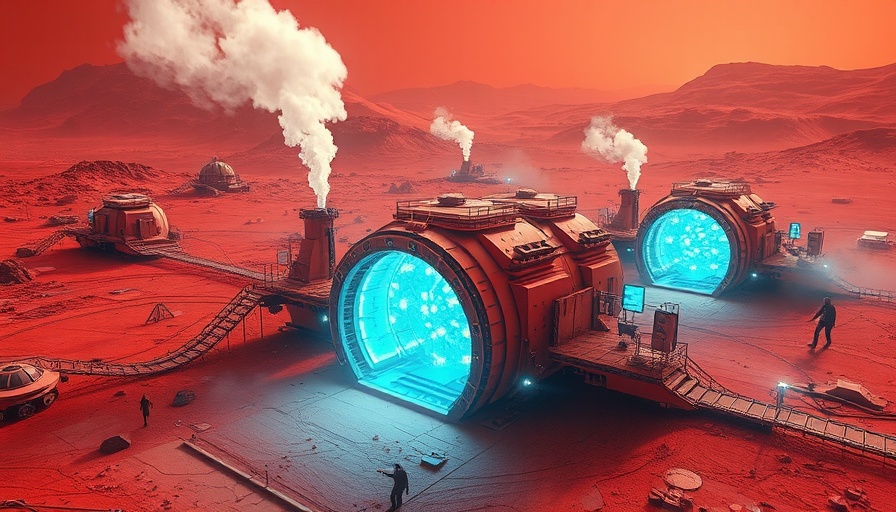
The Quest for Oxygen: A Breakthrough Technology for Mars and Beyond
As humanity embarks on a mission to explore Mars and beyond, a groundbreaking technology promises to significantly alter the way we think about oxygen supply and carbon management in extraterrestrial environments. A team of researchers from Nanjing University has unveiled an innovative electrochemical process capable of generating oxygen by splitting carbon dioxide (CO2) into elemental carbon and oxygen. This technology does not rely on complex conditions, making it suitable for the distinct atmosphere of Mars, which is primarily composed of CO2.
Why CO2 Splitting Matters in the Age of Climate Change
With the pressing need to combat climate change, finding efficient methods to handle CO2 emissions is more crucial than ever. The process developed by the Nanjing team employs lithium as a mediator instead of hydrogen, achieving an impressive oxygen yield of over 98.6%. This remarkable efficiency markedly surpasses natural photosynthesis, providing a potential blueprint for sustainable oxygen generation on Earth and beyond. The promising implications for the exploration of Mars are particularly significant, as astronauts will require reliable oxygen supplies for life support during long missions.
A Dual-Purpose Technology: Earth and Mars Applications
The ability to convert CO2 into usable oxygen serves dual purposes. First, it addresses the critical challenge of greenhouse gas reduction by recycling CO2 and subsequently producing oxygen. This recycling method could help establish carbon neutrality if powered by renewable energy sources, playing a pivotal role in addressing global warming and pollution. Second, the same technology can assist in future Mars missions, providing oxygen directly from the planet's atmosphere for astronauts and colonists.
The Technical Backbone: How It Works
The electrochemical device designed by the research team features a unique arrangement: a gas cathode integrated with a nanoscale cocatalyst of ruthenium and cobalt, paired with a lithium metal anode. CO2 enters the cathode and undergoes a two-step electrochemical reduction, initially creating lithium carbonate. This compound then reacts to produce lithium oxide and ultimately releases oxygen.
This innovation opens new frontiers in technology, particularly for life support systems, space habitats, and industrial waste management. Similar techniques can be applied underwater or in control settings on Earth, showcasing the versatility of this process in many contexts.
Future Trends: Oxygen and Life Beyond Earth
As we look toward the future, the technology for generating oxygen from CO2 demonstrates the kinds of innovations critical for space exploration. Such breakthroughs will determine the feasibility of human life on other planets, particularly Mars, as we prepare for more extensive missions in the coming decades. With the advancement of technologies that sustain life in harsh environments, we pave the way for deeper exploration and eventual colonization.
A Social Responsibility: Communicating and Implementing Knowledge
Given the implications of this research, it’s also essential for scientists and communicators to disseminate these findings to the general public effectively. Understanding how this technology intersects with climate change and exploration will help manage public perception and garner support for ongoing projects and funding. Indeed, as we manage the balance between technological growth and sustainability, our efforts must extend to educating the next generation about these developments.
Get Involved: The Importance of a Sustainable Lifestyle
As exciting as these scientific developments may be, their successful implementation also requires a shift in societal norms and attitudes towards sustainability. Whether you’re living in bustling Dallas or far beyond, understanding and advocating for sustainable practices can make a significant difference. Engage with local sustainability initiatives, support green tech, and embrace innovative solutions in your daily life.
As we prepare for a future where Mars exploration becomes a reality, learning about technologies like CO2 splitting will not only enhance our understanding of carbon neutrality but also emphasize the importance of a sustainable and responsible approach to technology. Every step toward understanding and addressing these issues brings us closer to a more sustainable world, both on Earth and beyond.
 Add Element
Add Element  Add Row
Add Row 



 Add Row
Add Row  Add
Add 


Write A Comment